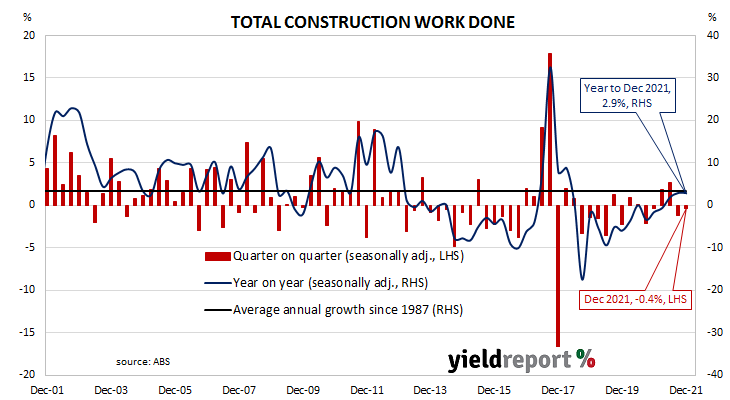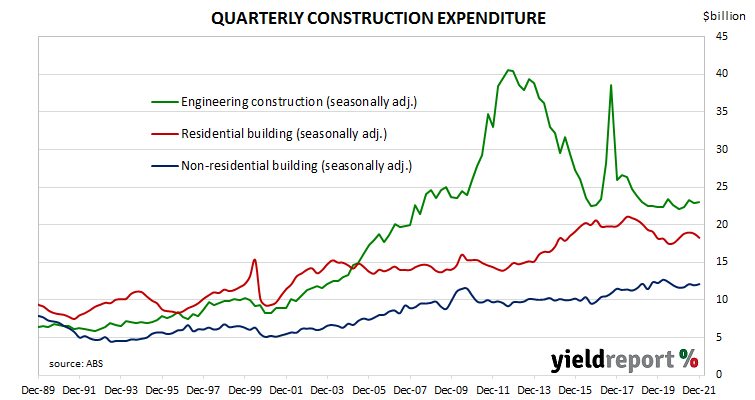Summary: Construction spending declines 0.4% in December quarter; fall contrasts with 2.5% increase expected; delta disruptions more extended than anticipated; residential sector down 2.9%, non-residential building up 1.3%, engineering up 0.7%.
Construction expenditure increased substantially in Australia in the early part of last decade following a more-steady expansion through the 2000s. A large portion of the increase came from the commissioning of new projects and the expansion of existing ones to exploit a tripling in price of Australia’s mining exports in the previous decade. Growth rates began slowing in 2017 and the return to “normal” investment levels may now have taken place.
According to the latest construction figures published by the ABS, total construction in the December quarter declined by 0.4%. The fall was in contrast with the 2.5% increase which had been expected but it was not as large as the September quarter’s 1.4% decrease after it was revised down from -0.3%. On an annual basis, the growth rate remained unchanged at 2.9%.
“The disruptions associated with the delta outbreak had a more extended impact than anticipated, particularly in Victoria, where several lockdowns have distorted the profile of activity,” said Westpac senior economist Andrew Hanlan.
The figures were released at the same time as the latest Wage Price Indices and domestic Treasury bond yields moved noticeably higher on the day. By the close of business, the 2-year ACGB yield had jumped 8bps to 1.75%, the 10-year yield had gained 7bps to 2.28% while the 20-year yield finished 4bps higher at 2.72%.
In the cash futures market, expectations of the actual cash rate’s path over time remained largely unchanged. At the end of the day, contract prices implied the cash rate would not exceed the RBA’s 0.10% target rate until May and then rise to 0.555% by August. February 2023 contracts implied a cash rate of 1.445%.
“Looking through the noise created by delta, the construction sector is experiencing an underlying uptrend in work. This is in response to substantial policy stimulus; notably, record low interest rates, the HomeBuilder program and additional public works,” Hanlan added.
Residential building construction expenditures fell by 2.9%, down from the September quarter’s -0.8% after revisions. On an annual basis, expenditure in this segment was 0.6% higher than the December 2020 quarter, down from the September quarter’s revised figure of 7.2%.
Non-residential building spending increased by 1.3%, in contrast with the previous quarter’s -1.2%. On an annual basis, expenditures were 4.1% higher than the December quarter of 2020. The September quarter’s comparable figure was 0.3% after revisions.
Engineering construction increased by 0.7% in the quarter, a turnaround from to the previous quarter’s -1.5% after revisions. On an annual basis, spending in this segment was 4.2% higher than the December 2020 quarter, up from the September quarter’s comparable figure of +1.0% after revisions.
“Victoria is once again the source of surprise,” said Westpac senior economist Andrew Hanlan. He noted construction work in Victoria had increased by 5.8% while in other states jurisdictions construction had increased by 1.1%.
Quarterly construction data compiled and released by the ABS are not considered to be of a “primary” nature in the same way as unemployment (Labour Force) and inflation (CPI) figures. However, the figures are viewed by economists and analysts with interest as they directly feed into quarterly GDP figures.



